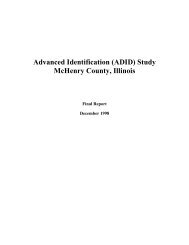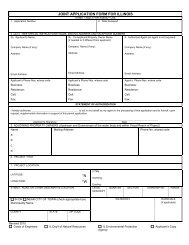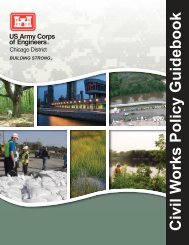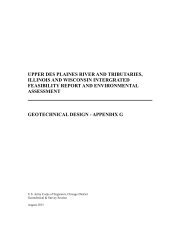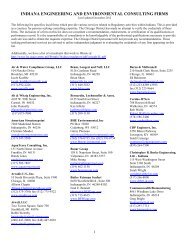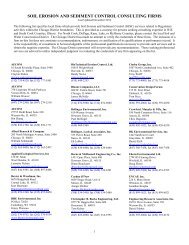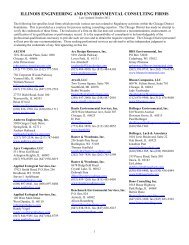Regional Permit Program - Chicago District - U.S. Army
Regional Permit Program - Chicago District - U.S. Army
Regional Permit Program - Chicago District - U.S. Army
You also want an ePaper? Increase the reach of your titles
YUMPU automatically turns print PDFs into web optimized ePapers that Google loves.
a) particle size analysis is conducted and demonstrates the material to be at least 80% sand or largersize material, using #230 U.S. sieve; orb) excavation and backfilling are done under dry conditions.10. Backfill used within trenches passing through wetland areas shall consist of clean material which willnot cause siltation, pipe damage during placement, or chemical corrosion in place. Excavated materialshall be used to the extent practicable, with the upper six (6) to twelve (12) inches backfilled with thetopsoil obtained during trench excavation.11. Any applicant proposing activities in a mined area or previously mined area shall provide to the IEPA awritten determination regarding the sediment and materials used which are considered “acid-producingmaterial” as defined in 35 Il. Adm. Code, Subtitle D. If considered “acid-producing material,” theapplicant shall obtain a permit to construct pursuant to 35 Il. Adm. Code 404.101.12. Asphalt, bituminous material and concrete with protruding material such as reinforcing bar or mesh shallnot be 1) used for backfill, 2) placed on shorelines/stream banks, or 3) placed in waters of the State.13. Applicants that use site dewatering techniques in order to perform work in waterways for constructionactivities approved under <strong>Regional</strong> <strong>Permit</strong>s 1 (Residential, Commercial and Institutional Developments),2 (Recreation Projects), 3 (Transportation Projects), 7 (Temporary Construction Activities), 9(Maintenance) or 12 (Bridge Scour Protection) shall maintain flow in the stream during suchconstruction activity by utilizing dam and pumping, fluming, culverts or other such techniques.14. In addition to any action required of the <strong>Regional</strong> <strong>Permit</strong> 13 (Cleanup of Toxic and Hazardous MaterialsProjects) applicant with respect to the “Notification” General Condition 22, the applicant shall notify theIllinois EPA Bureau of Water, of the specific activity. This notification shall include informationconcerning the orders and approvals that have been or will be obtained from the Illinois EPA Bureau ofLand (BOL) for all cleanup activities under BOL jurisdiction, or for which authorization or approval issought from BOL for no further remediation. This <strong>Regional</strong> <strong>Permit</strong> is not valid for activities that do notrequire or will not receive authorization or approval from the BOL.2. Threatened and Endangered Species - If the <strong>District</strong> determines that the activity may affect Federally listedspecies or critical habitat, the <strong>District</strong> will initiate section 7 consultation with the U.S. Fish and Wildlife Service(USFWS) in accordance with the Endangered Species Act of 1973, as amended (Act). Applicants shall provideadditional information that would enable the <strong>District</strong> to conclude that the proposed action will have no effect onfederally listed species.The application packet shall indicate whether resources (species, their suitable habitats, or critical habitat) listedor designated under the Act, may be present within areas affected (directly or indirectly) by the proposedproject. Applicants shall provide a section 7 species list for the action area using the on-line process at theUSFWS website. You can access "U.S. Fish and Wildlife Service Endangered Species <strong>Program</strong> of the UpperMidwest" website at www.fws.gov/midwest/Endangered. Click on the section 7 Technical Assistance greenshaded box in the lower right portion of the screen and follow the instructions to completion. Review alldocumentation pertaining to the species list, provide the rationale for your effects determination for eachspecies, and send the information to this office for review.If no species, their suitable habitats, or critical habitat are listed, then a “no effect” determination can be made,and section 7 consultation is not warranted. If species or critical habitat appear on the list or suitable habitat ispresent within the action area, then a biological assessment or biological evaluation will need to be completed todetermine if the proposed action will have “no effect” or “may effect” the species or suitable habitat. The<strong>District</strong> will request initiation of section 7 consultation with the USFWS upon agreement with the applicant onthe effect determinations in the biological assessment or biological evaluation.7



